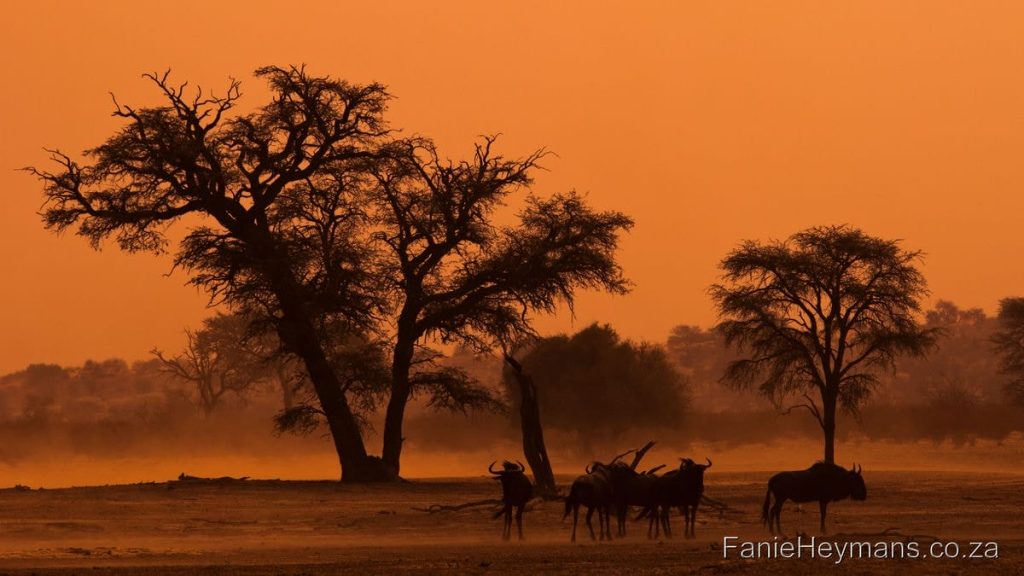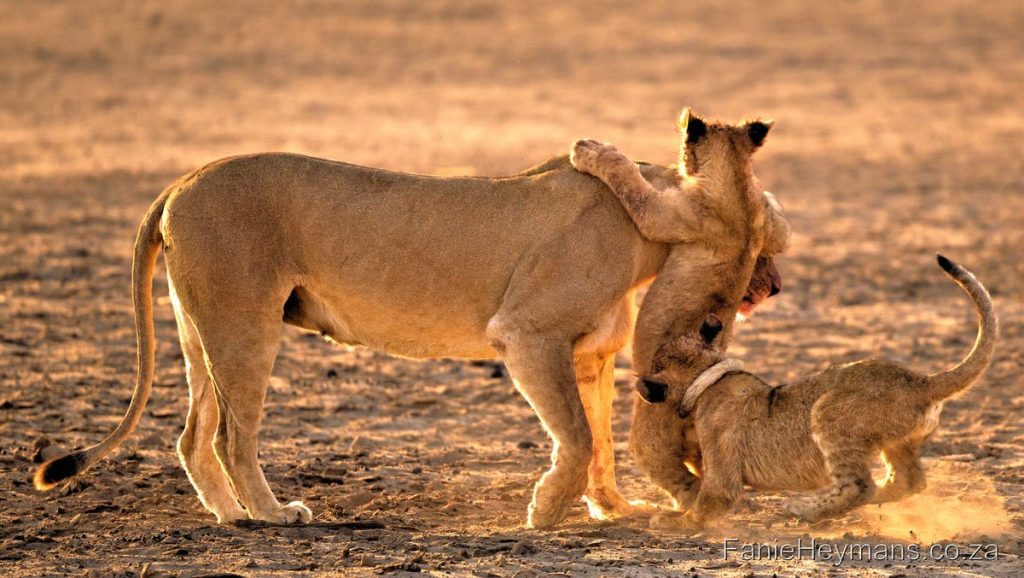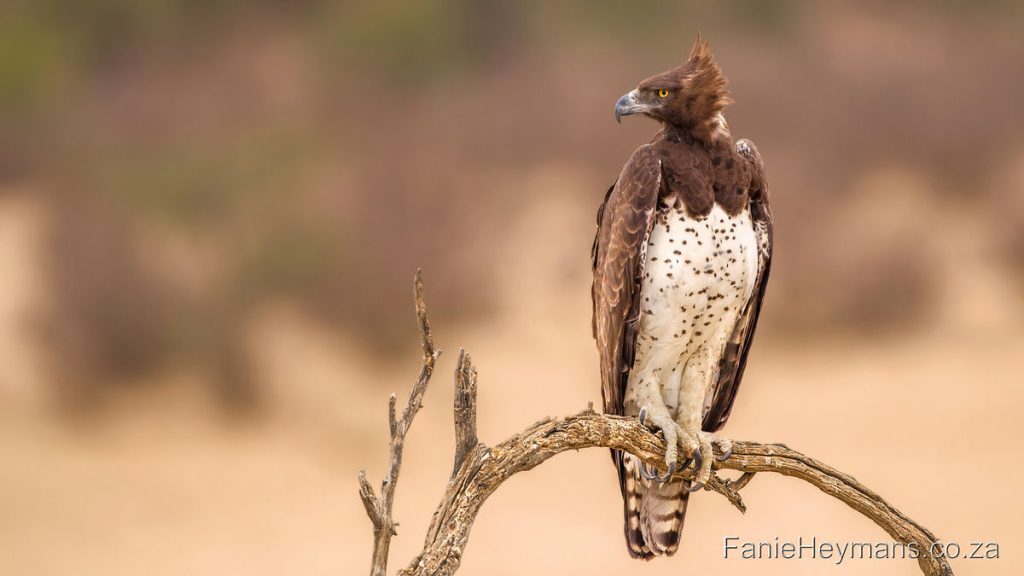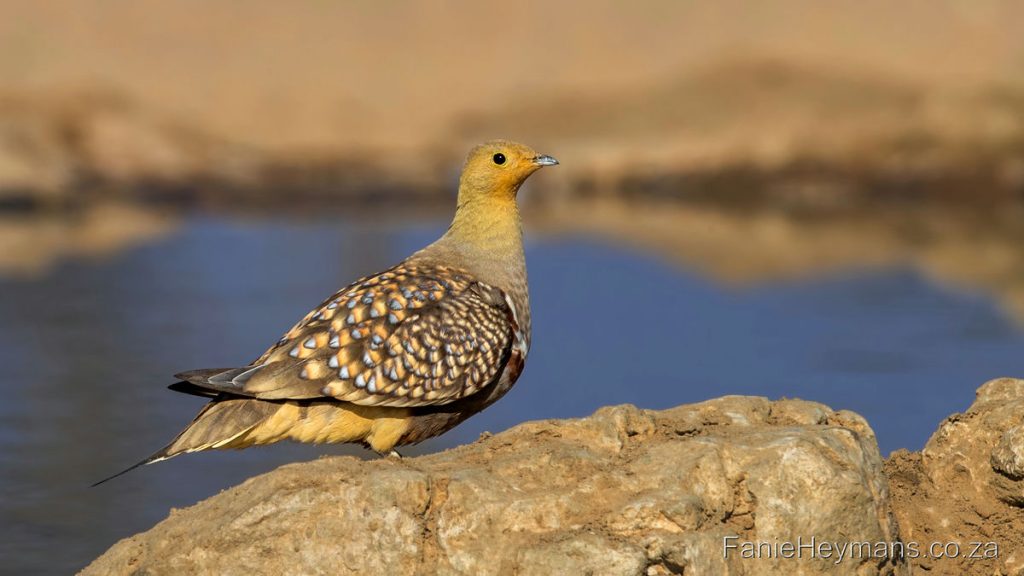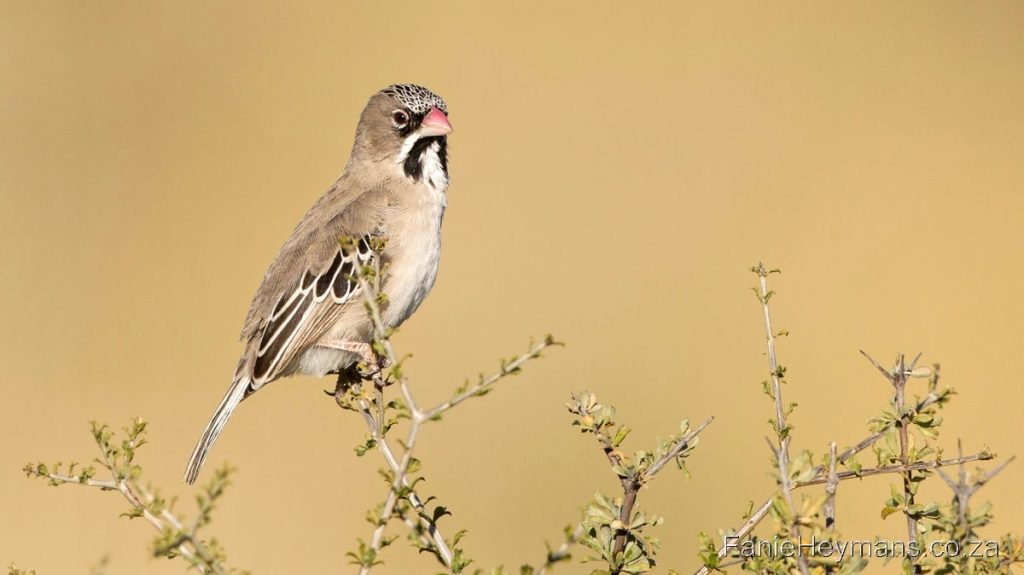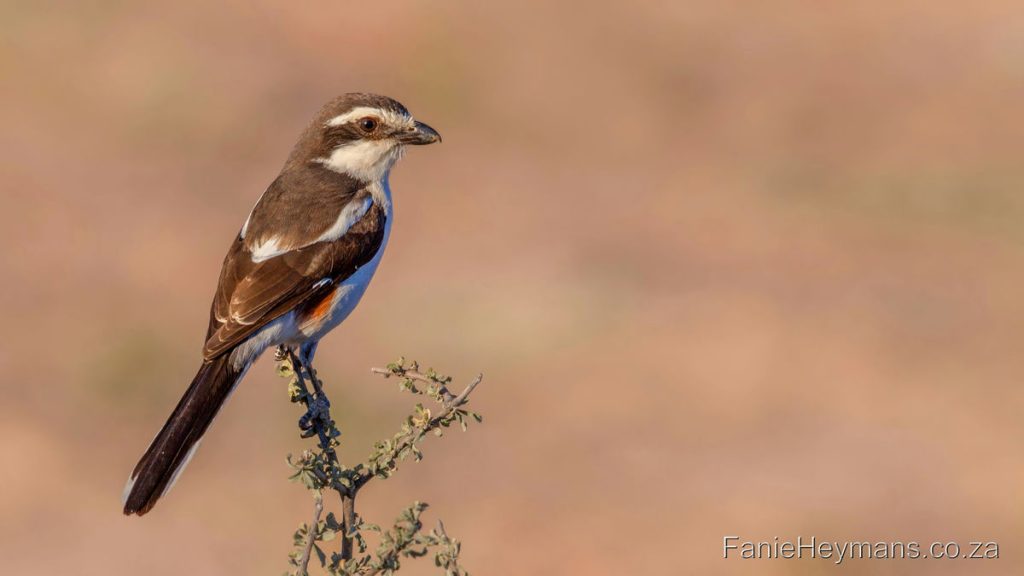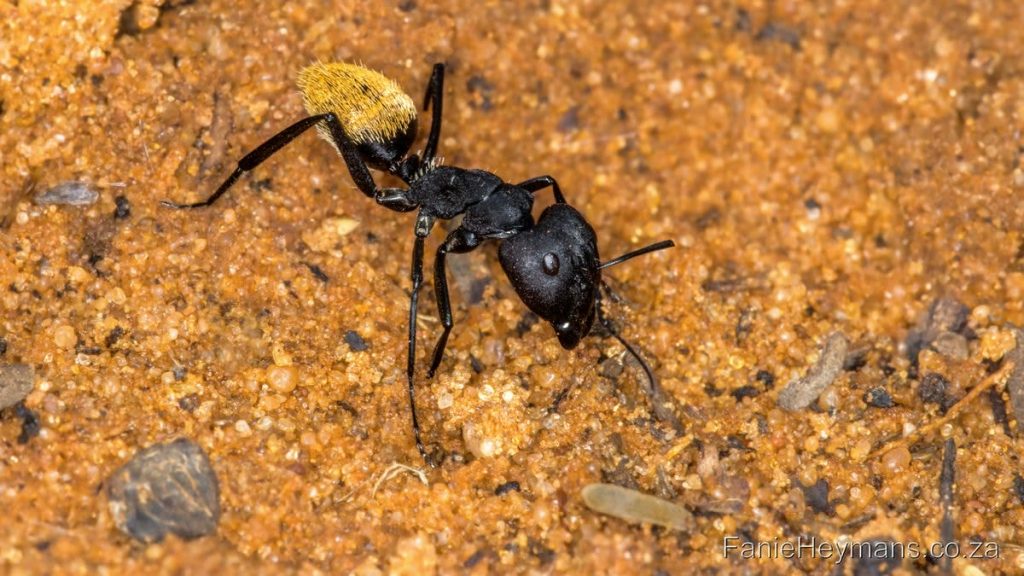Kgalagadi Trans frontier Park South Africa – Botswana
Kgalagadi is one of the most popular places in South Africa to experience wildlife, especially predators. Every aspiring wildlife photographer has to visit the Kgalagadi, and it should definitely be on their “to do” list if you have not been there before.
Kgalagadi means “place of thirst”.
The ring-necked dove also known as the Cape turtle dove or half-collared dove. All drinking water at the same time.
The Kgalagadi Trans frontier Park is a large National wildlife game reserve and conservation area in Southern Africa. The park straddles the border between South Africa and Botswana and comprises two adjoining national parks: Kalahari Gemsbok National Park in South Africa and the Gemsbok National Park in Botswana. The total area of the park is 38,000 square kilometers (15,000 sq. mi). Approximately three-quarters of the park is situated in Botswana and one-quarter in South Africa.
Kgalagadi Sunset
A beautiful sunset in the Kgalagadi. One of many breathtaking sunset or sunrise sightings in the Kgalagadi.
It is our most favourite place for wildlife photography, due to the vastness of the area and the result is uncluttered photographs. There are three main camps, Twee Rivieren, Mata-Mata and Nossob and a few wilderness camps. The main Camps are well equipped with campsites, chalets, a shop for obtaining basic foods or equipment, and have very good ablution facilities. Kalahari Black-mane Lions, Leopard, Cheetah, Brown Hyena, Spotted Hyena, Honey Badgers, Meerkat, African wild cats, and raptor species, including the majestic Martial, Tawny Eagles and the famous Bateleur Eagles are some of the highlights to look out for.
Male and Female Bateleur Eagle
The Bateleur or “Berghaan” in Afrikaans. This male and female eagles just landed at Qubitjie Quap waterhole. They are mainly scavengers, but do hunt occasionally.
Below is a lioness playing with her cubs. It is this kind of action that you can expect to see in this dry arid region in South Africa. The waterholes are clear from shrubs and thickets, as well as the river beds where most of the action is taking place. It is this uniqueness that distinct the Kgalagadi from any other national park in South Africa. It is truly a photographer’s haven.
Lioness and Cubs
Lioness and cubs playing in the early morning at Marie se draai.
Lions are one of the biggest attractions in Africa. It is a large well-muscled cat, most active during the night and sleeps most of the time during the day. Male lions sleep up to 20 hours of the day. It is the female lions that do all the work, by hunting and killing most of the prey. The big black manes are contributing to the male lions’ magnificent and beautiful appearance. It makes it looks much more intimidating and powerful. Lions are very social animals and lives in a pride that can range from small groups as little as 5 to groups larger than 30.
Big African Male Lion
This Big African Male Lion (Panthera Leo) created a lot of havoc when chasing all the teenagers around. He was attempting to take over the pride trying to mate with a female.
Below two big full grown male lions in their prime, teaching a younger male a lesson or two. The fight was severe, and one could feel the trembling on the ground as they were roaring, but this is the mature predators’ way to kick the younger males out of the tribe. The mature lions want to mate with the females, and take over the pride.
Lion Fight
Two adult male lions attacking a younger male lion, teaching him a lesson at Marie se Draai water hole.
Leopard – Panthera Pardus
The leopard – Panthera pardus – (“Luiperd”) is a member of the Felidae family. They are a medium-sized cat that is found in a variety of different habitats across sub-Saharan Africa. They usually keep to themselves, lurking in dense bush or around rocky areas, emerging to hunt late in the afternoon or at night.
Here are two female leopards fighting. It was not the “right time of day”, surely not the best light or the best images, but wow, what an experience! (Like only the female species can do. A real “CAT….” fight.) Check out my Trip report Leopard fight to see more images.
Leopard Fight
In the photo it looks like both female leopards are balanced on their tails. This was definitely a territorial fight. We were following the one leopard in the river bed, and was surprised to see another leopard from the opposite direction, walking towards the one we were following. The next moment all hell break loose. A cat fight like I have never seen before. The fight only lasted for a few seconds, but it was a vicious few second between these two ladies.
The two moved up the hill behind some bushes and one could still hear some snarling, but we never saw them again. To read the full story of this cat fight read my trip report “Leopard Fight in Kgalagadi” The fasted predator/land animal in the world is the Cheetah. It reaches speeds of up to 100km/h and faster. This high speed is normally reached in just a few seconds from charging its prey. Normally after 250 meters it running out of breath and will cease the chase. It feeds on small to medium antelope, and in the Kgalagadi you can be sure to see charge or two for a Springbok, ostrich or bat eared foxes.
Cheetah
Two Cheetah’s siblings drinking water. A graceful predator that is identified by their unique black spots on gold or yellow coats and are known for their amazing speed.
Another rare cat species to see is the African Wild Cat and Caracal. The Wild Cat is very similar to a domestic cat, and can easily be mistaken for a domestic cat. It is however, proportionally larger and has longer hind legs. Some of its characteristics are the black soles of its feet, whereas the domestic cat has pinkish feet soles. It is a solitary cat outside the breeding season. It lives from mouse and rats and will occasionally eat birds.
African Wildcat
The African Wildcat is the ancestor of the Domestic cat. This species of cat is widely distributed and has a wide variety of coat colours to help it blend into its environment. Wildcat sitting in Nossob River.
Caracal
Caracal at Marie se Draai waterhole, clearly out on the hunt. Caracals are impressive medium-sized wild cats with powerfully built, long legs, broad front legs, short tails and pointed ears with long tufts. They specialize in hunting flying birds by jumping upwards vertically to heights of over 2m and catching a bird in flight
Brown Hyena
Brown Hyena charging at a Lion cub.
A Brown Hyena also called a “Strandwolf”, charging at a Lion that cornered him at a waterhole. The Brown Hyenas is mostly a scavenger, but will feast on smaller things like mouse, insects and bird eggs. When confronted, they will raise their long brown hair to look bigger and more intimidating. They are very shy animals and not spotted regularly.
Spotted Hyena with antelope bone
Spotted Hyena with antelope bone. She was running up and down with the bone, like she was playing with the whole family. Spotted Hyenas are not members of the dog or cat families. Instead, they have their own family, called the Hyaenidae.
We were on our way out when we saw a carcass of an Eland Bull. These two Black Back Jackals were fighting over who may feast first and who not. An event that plays off daily in the Kgalagadi for survival of the fittest.
Black-Back Jackal
Two black-backed jackals fighting over food.
They are highly vocal creatures and can be heard calling every night in camp. As its name suggests, the Black-backed jackal has a black saddle on its back running from the neck and narrowing to the tail. They have a black-tipped tail. Jackals have erected and pointed ears which facilitate excellent hearing.
Bat Eared Fox
They resemble small jackals, but they are not jackals. Bat-eared foxes are carnivores (insectivores). The foxes’ large ears, which can measure over 12cm long, help them hear insects underground.
Martial Eagle
Martial Eagle at the Nossob Hide
They are the largest of the African eagles and incredibly powerful with a length reaching up to 96 cm long and a weight up to 6.5 kg. Females are on average are 10% larger than males in height. They hunt mainly on the wing, soaring above the park, and can spot potential prey from up to 6km away.
Bateleur Eagle
This Bateleur coming in for a landing at a waterhole. The Bateleur (Terathopius ecaudatus) eagle is the most famous of the snake eagles.
Juvenile Bateleur Eagle
Juvenile Bateleur Eagle Landing
The Bateleur Eagle (Berghaan in Afrikaans) is one of South Africa’s most beautiful eagles. It takes a juvenile 7 years to reach maturity. If you want to photograph this large eagle, then Qubitje Quap waterhole, about 10km north from Nossob rest camp, is the place to be. This is their favourite waterhole, and you will find them there in midday to early afternoon. They are excellent models to photograph and very photogenic.
Tawny Eagle
Beautiful Tawny Eagle at Qubitje Quap waterhole. Tawny Eagles are medium-large eagles in size, measuring up to 72cm in length. It is a large eagle, and as its name says, it is tawny in colour with piercing golden yellow brown eyes. I was very lucky to photograph this eagle at such close range during a previous trip to the Kgalagadi.
Lanner Falcon
Lanner Falcon flying with a dove in its claws, at Kwang water hole. Using extremely high speeds it surprises its prey mostly mid-air. Lanner Falcon, a smaller raptor, is best known for the high speeds of up to 150 km/h, in which it comes in low and fast. It will strike a bird in flight and stun it. It will then follow it to the ground and kill it. This image shows the Lanner Falcon with a dove in its claws.
Pale Chanting Goshawk
A tall, long-tailed, pewter-grey hawk with pink-orange legs and bill base. In flight the wing pattern is strongly contrasting, with pale inner hind wings. It is one of the few African species recorded to hunt co-operatively behind the honey badger.
African Pearl Spotted Owl
White Face Scops owls are one of Southern Africa’s smaller owls, but has big large eyes. We were able to photograph them at the Nossob Campsite.
Springbok
This two male Spring-buck is fighting in Kgalagadi. Dust everywhere. The fight lasts for almost 5 minutes until one of them submits and run away.
Springbok fights is the norm in spring season, when these animals’ mate. Big herds can be found in the river beds. A unique feature of the Springbok is pronking. It takes several leaps into the air with the back bowed and the white flap lifted. They are very tame, and have right of way in the roads.
Red Hartebeest
Red Hartebeest in the Auob River. The Red Hartebeest is a large, antelope. They live in herds up to 20 and are grazers. Apparently, their eyesight is not that good. Red hartebeest on the run, once in its stride, a hartebeest can achieve a speed of up to 65km/h. They have crooked horns and are grazers.
In the Botswana side, there are a few popular wilderness campsites as well. Rooiputs, Polentswa, Mabuasehube, are but a few. There are no fences, and the predators and other animals visit the campsites on a daily basis. This may cause much havoc around camp, especially if you want to setup or pack up camp, and there are several lions making themselves at home in the campsite, at the same time.
Blue Wildebeest
This Blue Wildebeest (Connochaetes Taurinus) was kicking up dust. Blue wildebeest are large antelope, they are ruminants and have cloven hooves. Both genders have horns, the male horns are larger than the females. They are characterized by a long black mane and a beard of hair hanging from the throat and neck.
Gemsbok Fighting
Two Gemsbok bull’s territorial fight. The Gemsbok (Oryx gazelle) is a large antelope in the Oryx genus. It is native to the dry arid regions of Southern Africa. Oryx adapted to live in the dessert and get their water from the food they eat. They have long spear horns witch are very dangerous. They are very aggressive when cornered or injured and there are stories of them killing Lions, (one of the main predators who hunts them), with their sharp horns.
Giraffe
Giraffe staring down to a Jackal drinking water next to him. The giraffe is the tallest animal in the world, attaining a height of 5.5m, its incredibly long neck accounting for much of its height.
Meerkat
The Meerkat (Suricata Suricatta) or Suricate is a small mongoose. These social animals live in groups, called mobs, with as many as 30 individuals. The younger ones are doing babysitting duties, whilst the rest of the mob is out foraging for scorpions and other insects.
Slender Mongoose
The common slender mongoose, also known as the black-tipped mongoose or the black-tailed mongoose, is a very common mongoose in the Kgalagadi.
Have a look at the smaller animals around you as well. You would be surprised at all the other photographic opportunities in this park, besides the big predators.
Smaller animals-birds and insects
Grimson Breasted Shrike
Pair of Crimson-breasted shrike on a branch near the waterhole. This is another beautiful bird which you will definitely see everywhere. You will normally find them on the ground under big trees or in the trees itself.
Male Sandgrouse
Male Sandgrouse drinking water at Qubitje Quab. Sandgrouse are desert birds, and so well adapted to life in this arid region of Northern Cape province that they’ve even solved the problem of carrying water long distances for their chicks.
Little Bee-eater
One of Africa most common and widespread Bea-eater is the Little Bee-eater. They are mostly found in Sub Saharan Africa. They love to catch insect in mid-air and then with their beak hitting the insect against a branch before swallowing it.
There are several well-spaced waterholes along the routes in the Nossob and Auob river beds. Some of the waterholes have sweet water and others have salty water. Drive slowly and be patient. The best time for photography is early mornings and late afternoons, when the light is perfect for photography. The red dunes and the dusty sunsets are really something. The quietness and the remoteness of this region gets under one’s skin very quickly, and there is always a reason to go back.
Social Weaver
A small, dumpy buff-and-brown weaver. The sociable weaver is insectivorous with insects comprising 80% of their diet. Sociable weavers build massive colonial nests that hang 4m high in trees. We have visited the Kgalagadi several times before, and each time we visited the park, there was different action for each trip. It never disappoints and is full of surprises.
Common Fiscal Shrike
The common fiscal is also known as ‘butcher bird’, due to its habit of impaling its prey, such as a scorpion or a small gecko on a thorn for later consumption.
Lilac Breasted Roller
Lilac-breasted Rollers are fond of open woodland and adaptable to a range of savanna types, of grassland.
A good tip for all the aspiring photographers out there: does not charge up and down the river bed from one waterhole to the other, searching for big game like the lion, leopard or cheetah. Lions are mainly nocturnal, can sleep up to 20 hours a day, and are therefore not always good photographic models.
African Forked Tailed Drongo
A red-eyed all-black upright bird with a narrow tail that splays out into a deep fork.
Spotted Thick-knee
The Spotted Thick-knee, is a ground-nesting species. Its huge yellow eyes hint at its mainly nocturnal habits. By day this odd species uses its cryptic plumage to conceal itself under cover. After dark, it emerges to run around feeding on insects.
Yellow Canary
A large canary with different-looking males and females. The male has bright yellow underparts, yellow-green upperparts, and a well-marked face pattern
Kori Bustard
The Kori Bustard is Africa’s heaviest flying bird and can weigh up to 19kg. They ground-dwelling birds that that eat a variety of insects, small animals and some plants.
Cape crow
The Cape crow or black crow is slightly larger than the carrion crow and is completely black with a slight gloss of purple in its feathers. In May and in August 2023, we were fortunate enough to visit the park twice. Animals moved to the north since there were veld fires two years ago, but they are now slowly returning to the southern parts again, and we were still lucky enough to had beautiful sightings of both animals and birds on both occasions.
Elephant Shrew
The cute elephant-nosed shrew’s main diet is invertebrates and insects like termites, ants, worms, and spiders. Elephant Shrew photographed at the Qubitje Quap waterhole, Nossob River. It was busy eating some seeds adjacent to our vehicle.
African striped mouse
African striped mouse, or Four-striped Grass Mouse eating some seeds in the desert sand
Tiger Snake
Tiger Snake. A slow-moving nocturnal snake that hunts for lizards, especially geckos, nestling birds, bats and small rodents. Photographed at Mabuasehube campsite.
Blue Headed Tree Agama
Blue Headed Tree Agama – Agama Atri Collis. It is often seen on the trunks of trees, where the blue head of the breeding male is hard to miss.
Wasp
Wasp at a remote tap with in Mabuasehube, Botswana side, busy drinking water
Honey Bee
Honey Bee at the same tap, in Mabuasehube camp. There were quite a few insects at this tap that was leaking water.
Balbyter Ant
The genus Camponotus – the Sugar ants or better known as Balbyter – are large, growing up to and larger than 20mm.
When you want to make a reservation for accommodation at the Kgalagadi, then do so well in advance, to prevent disappointment. It is advisable to do your reservation at least 12 months in advance. There is quite a few Wilderness Camps in the Kgalagadi as well. Although we normally love to stay in the main camps, we believe that it is really worthwhile to visit the wilderness camps too.
Check out some more of my photos at 500PX and PhotoPixSA and the Trip Reports and Hiking Trails


